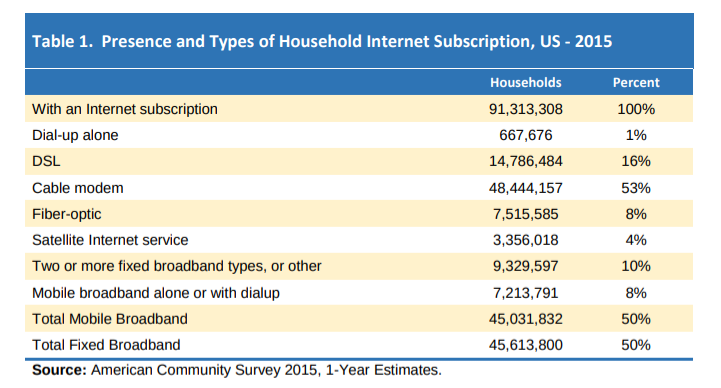Assumptions matter. Consider estimates of internet access using fixed networks of all types. Some have estimated the total number of homes (accounts) as low as 46 million, in 2015. Other estimates (2018 figures) put the number of U.S. fixed network internet access accounts at a minimum of 97 million.


Growth rates for fixed network internet access simply are not high enough to get to 97 million from 46 million in several years. So those high and low estimates have to be making different assumptions.
There are many possible reasons for the sharp divergence. Since the definition of “broadband” changes from time to time, one plausible explanation is that the lower estimates are based on the latest and “fastest” definitions. But estimates of broadband adoption seem to vary wildly.
One estimate from the World Bank in 2015 suggested broadband adoption was only about 30 percent in the U.S. market, which few would consider close to reality. An estimate based on U.S. Census Bureau data from about the same time pegged home use of the internet at 75 percent.
Another plausible explanation is that some researchers use a “homes that buy broadband” figure, which speaks to buy rates, not the “I can buy, but choose not to buy” figure, which represents the “I could buy if I wanted to” number.
Yet other estimates might simply count the number of either “homes passed” by networks offering internet access service or the number of buyers of internet access at any speed.
All those choices matter.
The point is that one has to be very careful about assumptions about how many people, homes, or businesses have access to internet access or broadband; how many people have access; what speeds they can purchase; what speeds they do purchase; or what percentage of potential buyers have supplier choice or how many are choosing to use platforms other than a cabled network.
One fact seems clear enough: the number of homes and businesses able to buy a reasonably-fast internet access service continues to inch upwards. In the 5G era, the number of locations able to buy much-faster services should take a step function upwards, with order of magnitude speed increases (10 times) for many U.S. households.
In the meantime, incremental progress is being made.
Some 700,000 U.S. rural homes and small businesses will gain access to high-speed internet access for the first time through the Federal Communications Commission’s Connect America Fund Phase II auction, auction results released today show, and more than half of those 713,176 locations will have service available with download speeds of at least 100 megabits per second.
Connecting 700,000 homes in a nation with perhaps 138.3 million housing units, that might not sound like much. But the 250,000 most-isolated rural locations account for about half the estimated cost of connecting seven million U.S. homes in rural, hard to reach areas.
Of course, the most-isolated areas likely always will be among the best candidates for satellite or other wireless access platforms. Perhaps three million rural locations already buy satellite internet access.
That “cost to reach” logically implies that the great bulk of new investment under this program will support extension of service to new locations that are not the most-isolated, as that provides the greatest efficiency. In other words, service providers logically will connect the new locations in some proximity to current networks, rather than taking on the most-difficult, most-expensive areas .
According to plan, 53 percent of all homes and businesses served with support from the auction will have broadband available with download speeds of at least 100 megabits per second. Some 19 percent will have gigabit service available. And 711,389 locations—all but 0.25 percent—will have at least 25 Mbps service.
It appears a great many of the providers are ISPs using fixed wireless.
Providers must build out to 40 percent of the assigned homes and businesses in a state within three years of becoming authorized to receive support. Buildout must increase by 20 percent in each subsequent year, until complete buildout is reach at the end of the sixth year.
The auction allocated $1.488 billion in support to be distributed over the next 10 years to expand rural broadband service in unserved areas in 45 states. A total of 103 providers will get funds.
No comments:
Post a Comment